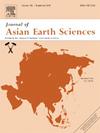Interplay of abiotic, biotic, and environmental controls on travertine formation: Insights from Baishuitai (White Water Terraces), Southwest China
IF 2.4
3区 地球科学
Q2 GEOSCIENCES, MULTIDISCIPLINARY
引用次数: 0
Abstract
Travertines, striking carbonate formations created by mineral-rich spring waters, develop through an interplay of abiotic and biotic processes. Yet, the roles and interactions of these processes across travertine systems remain unclear. In this study, we investigated the Baishuitai, a large, active travertine in Southwest China, using geochemical and petrographic methods to explore how abiotic and biotic processes interact and drive travertine deposition and decipher the environmental factors controlling them. The results show that the travertines are precipitated by waters issuing from springs that have relatively low temperatures (∼10.8 °C) and are highly enriched in Ca2+ and HCO3− (∼200 mg/L and 770 mg/L, respectively) and CO2 (∼10−0.9 atm). Geochemical data (e.g., δ13CDIC: −0.1 ‰) confirm that these waters originate from a mix of meteoric recharge and deep-seated CO2 transported via neotectonic faults. Owing to the enrichment of CO2 in spring water, significant calcite precipitation occurs primarily through abiotic processes that are driven by rapid CO2 degassing along the flow path. Additionally, microbial biofilms greatly modulate the deposition by creating localized zones for mineralization, providing crystal nucleation sites, and trapping particles with their mucilage. The interplay of abiotic and microbially influenced processes varies in different depositional environments and is mainly governed by water chemistry dynamics, topography-driven flow conditions, biological growth pattern, and seasonal climate changes. The study illuminates the primacy of abiotic processes, the subtle yet crucial role of microbes, and the environmental controls sculpting travertine in low-temperature, CO2-rich systems, which has significance to the full understanding of the development of travertine formations.
非生物、生物和环境控制对石灰华形成的相互作用:来自中国西南白水台(白水梯田)的启示
石灰华,由富含矿物质的泉水形成的引人注目的碳酸盐地层,通过非生物和生物过程的相互作用而发展。然而,这些过程在石灰华系统中的作用和相互作用尚不清楚。本文以西南白水台大型活性钙华为研究对象,运用地球化学和岩石学方法,探讨了非生物和生物过程如何相互作用、驱动钙华沉积,并解析了控制它们的环境因素。结果表明,石灰华是由温度相对较低(~ 10.8°C)且富含Ca2+和HCO3−(分别为~ 200 mg/L和770 mg/L)和CO2(~ 10−0.9 atm)的泉水析出的。地球化学数据(例如δ13CDIC:−0.1‰)证实这些水是由大气补给和新构造断裂输送的深层CO2混合形成的。由于泉水中CO2的富集,方解石的显著沉淀主要是通过非生物过程发生的,该过程是由沿流动路径的快速CO2脱气驱动的。此外,微生物生物膜通过为矿化创造局部区域、提供晶体成核位置和用黏液捕获颗粒,极大地调节了沉积。在不同的沉积环境中,非生物和微生物影响过程的相互作用各不相同,主要受水化学动力学、地形驱动的流动条件、生物生长模式和季节气候变化的影响。该研究阐明了非生物过程的首要地位、微生物微妙但至关重要的作用,以及在低温富二氧化碳系统中雕刻钙华的环境控制,对充分认识钙华地层的发育具有重要意义。
本文章由计算机程序翻译,如有差异,请以英文原文为准。
求助全文
约1分钟内获得全文
求助全文
来源期刊

Journal of Asian Earth Sciences
地学-地球科学综合
CiteScore
5.90
自引率
10.00%
发文量
324
审稿时长
71 days
期刊介绍:
Journal of Asian Earth Sciences has an open access mirror journal Journal of Asian Earth Sciences: X, sharing the same aims and scope, editorial team, submission system and rigorous peer review.
The Journal of Asian Earth Sciences is an international interdisciplinary journal devoted to all aspects of research related to the solid Earth Sciences of Asia. The Journal publishes high quality, peer-reviewed scientific papers on the regional geology, tectonics, geochemistry and geophysics of Asia. It will be devoted primarily to research papers but short communications relating to new developments of broad interest, reviews and book reviews will also be included. Papers must have international appeal and should present work of more than local significance.
The scope includes deep processes of the Asian continent and its adjacent oceans; seismology and earthquakes; orogeny, magmatism, metamorphism and volcanism; growth, deformation and destruction of the Asian crust; crust-mantle interaction; evolution of life (early life, biostratigraphy, biogeography and mass-extinction); fluids, fluxes and reservoirs of mineral and energy resources; surface processes (weathering, erosion, transport and deposition of sediments) and resulting geomorphology; and the response of the Earth to global climate change as viewed within the Asian continent and surrounding oceans.
 求助内容:
求助内容: 应助结果提醒方式:
应助结果提醒方式:


